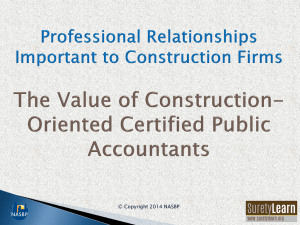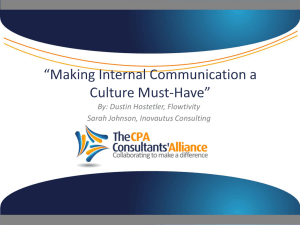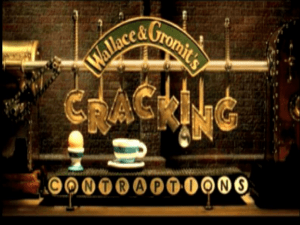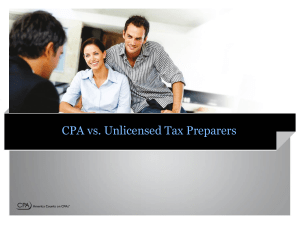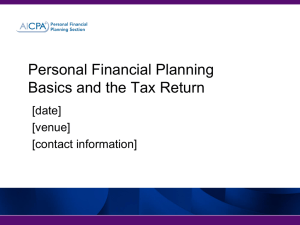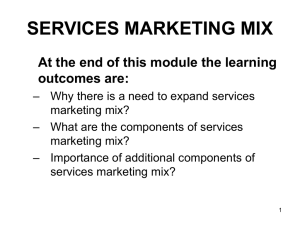Tangible Property Regulations
advertisement
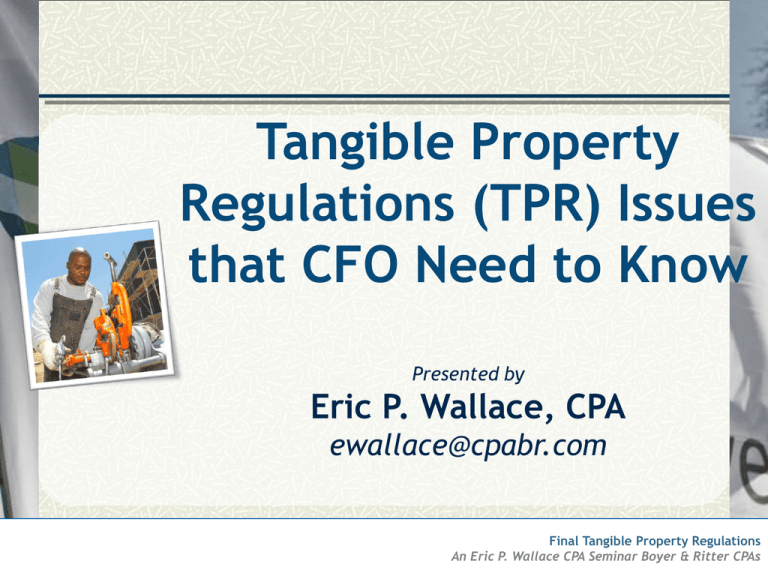
Tangible Property Regulations (TPR) Issues that CFO Need to Know Presented by Eric P. Wallace, CPA ewallace@cpabr.com Final Tangible Property Regulations An Eric P. Wallace CPA Seminar Boyer & Ritter CPAs First Discussion Topic The ‘Company’ Issues 1. Identifying the company issues that will arise from the final tangible property regulations (TPR) implementation 2. Review depreciation schedules for items that need corrections This review will guide you to issues to address for the TPRs 2 Final Tangible Property Regulations An Eric P. Wallace CPA Seminar Boyer & Ritter CPAs First Discussion Topic The ‘Company’ Issues 3. The filing of beneficial 3115s (those with negative 481(a) adjustments) for prior or partial building components disposed of (these are write offs) and the depreciation corrections (how to gather the facts) 4. Consider what 3115s will have to be filed in current and future years (no later than tax year 2014) 3 Final Tangible Property Regulations An Eric P. Wallace CPA Seminar Boyer & Ritter CPAs First Discussion Topic The ‘CPA In-House’ Issues 5. The internal processes your company will have to implement by 2014 (establish de minimis write-off amounts (now with or without if AFS), M & S, Capitalization policy for R & M, others) 4 Final Tangible Property Regulations An Eric P. Wallace CPA Seminar Boyer & Ritter CPAs First Discussion Topic Get a DMSH Policy in Place by 12-31-13 Non-AFS DMSH AFS DMSH To take advantage of either of these, a Taxpayer (TP) must have an accounting policy in place before January 1, 2014, if calendar year TP 5 Final Tangible Property Regulations An Eric P. Wallace CPA Seminar Boyer & Ritter CPAs First Discussion Topic Get a DMSH Policy in Place Want to take advantage of the DMSH for any TP? Can increase max write off per item/invoice to $500/$5,000 (nonAFS DMSH and AFS DMSH) 6 Final Tangible Property Regulations An Eric P. Wallace CPA Seminar Boyer & Ritter CPAs First Discussion Topic Get a DMSH Policy in Place An accounting policy in place response is required for all separate trades or businesses and any separate legal entities, such as singlemember LLC If no accounting policy in place or TP does not make the annual election, TP will be limited to $200 per item/invoice, but only for units of property… parts will have to be deferred, no matter what the $$amounts 7 Final Tangible Property Regulations An Eric P. Wallace CPA Seminar Boyer & Ritter CPAs DMSH Policy in Place Elements Non-AFS DMSH What are the required elements in an accounting policy for a non-AFS TP? 8 Final Tangible Property Regulations An Eric P. Wallace CPA Seminar Boyer & Ritter CPAs DMSH Policy in Place Elements Non-AFS DMSH Have an accounting policy in place Specify a write-off dollar amount Be in place before the beginning of the TP year Actually write the items off for books Apply the DMSH to all items that qualify 9 Final Tangible Property Regulations An Eric P. Wallace CPA Seminar Boyer & Ritter CPAs DMSH Policy in Place Elements AFS DMSH What are the additional required elements in an accounting policy for an AFS DMSH TP? 10 Final Tangible Property Regulations An Eric P. Wallace CPA Seminar Boyer & Ritter CPAs DMSH Policy in Place Elements The accounting policy MUST also, before the tax year: AFS DMSH Be documented Be communicated Have an applicable financial statement Note: With an AFS a TP will be writing the amounts off for financial statement 11 Final Tangible Property Regulations An Eric P. Wallace CPA Seminar Boyer & Ritter CPAs Depreciation Allowable or Taken—This Issue Is ‘HUGE’ Points 1. Use 2013 (i.e. tax depreciation schedules as of 1231-2012) to correct any errors in prior year depreciation, and 2. Section 1.1016-3 remains part of the TPRs for a reason—that is the “scary” part—the IRS will use this in their audits of TPs to deny depreciation deductions 12 Final Tangible Property Regulations An Eric P. Wallace CPA Seminar Boyer & Ritter CPAs A Warning About Depreciation—from the TPR Issue What is the amount of depreciation that a TP can take in a given tax year? A: What is allowed or allowable Ask yourself—Why was this new section included in the tangible property regs (Temporary (T) and Final (F))? To emphasize the fact that in depreciation deductions—you use it or lose it 13 Final Tangible Property Regulations An Eric P. Wallace CPA Seminar Boyer & Ritter CPAs What the ‘Repair’ Regulations Do Temporary and Final tangible property regulations (TPR) provide guidance (“Framework”) on the application of sections 162(a) (deduction) and 263(a) (requires capitalization) of the Code to amounts paid to acquire, produce, or improve tangible property Regulations aim to clarify the difference between these two opposites 14 Final Tangible Property Regulations An Eric P. Wallace CPA Seminar Boyer & Ritter CPAs The F and P TPR 6 Potential New Annual Elections The final and proposed TPRs have six new annual elections including 1, 2, 3: Three enable a TP to capitalize and depreciate certain items that could be written off for tax, but taxpayer wants to elect to capitalize instead Two others deal with real estate issues, the Last one, the de minimis safe harbor (DMSH) is a big item for contractors ……. 15 Final Tangible Property Regulations An Eric P. Wallace CPA Seminar Boyer & Ritter CPAs The F and P TPR New Annual Elections The De minimis safe harbor election (§1.162-3(f)(1)) does not require any method change. Here are its general tenents: A TP with and without an AFS may not capitalize any amount paid in the taxable year for the acquisition or production of a unit of tangible property nor treat as a material or supply under §1.162-3(a) any amount paid in the taxable year for tangible property if the amount specified meets the rules – $500 and $5,000 per invoice respectively 16 Final Tangible Property Regulations An Eric P. Wallace CPA Seminar Boyer & Ritter CPAs De minimis applies to all of these Application of the de minimis to TPR Issues §1.162-3 Rules for materials and supplies §1.162-4 Repairs and maintenance §1.263(a)-1 General rules for capital expenditures §1.263(a)-2 Rules for amounts paid for the acquisition or production of tangible property §1.263(a)-3 Rules for amounts paid for the improvement of tangible property 17 Final Tangible Property Regulations An Eric P. Wallace CPA Seminar Boyer & Ritter CPAs Definition of Material and Supplies We now have the following groups of types of M & S, when the final TPRs are effective 1 2 • Non-incidental (includes rotable, temporary, or standby emergency spare parts) • Fuel or Bulk 3 • Units of Property with life of less than one year 4 • Units of Property with cost of $200 or less 18 Final Tangible Property Regulations An Eric P. Wallace CPA Seminar Boyer & Ritter CPAs Visual Depiction of the Interaction of De Minimis to M & S and UoP Items First—Before we advance into the details of these main TPR issues, let’s summarize the interaction of the de minimis safe harbors and a) material and supplies (M&S); b) repairs and maintenance (R & M); c) UoP (Unit of Property) with lives less than one year, and d) UoP with lives greater than one year Note that I did not use the term “class lives,” but rather used the term ‘lives” There is a difference 19 Final Tangible Property Regulations A CCH Seminar Visual Application of the Final TPR Regulation and DMSHs No DMSH Cost Per Item M & S - No Units of Property UoP < one year < one year > one year life life life I NI < $200 WO Defer Defer WO WO > $200 but < $500 NA Defer Defer CAP CAP > $500 but < $5,000 NA Defer Defer CAP CAP > $5,000 NA Defer Defer CAP CAP Codes: I= Incidental, NI= Non-incidental UoP= Unit of Property (Acquisition) DMSH= de minimis safe harbor 20 Final Tangible Property Regulations An Eric P. Wallace CPA Seminar Boyer & Ritter CPAs Visual Application of the Final TPR Regulation and DMSHs No DMSH Cost Per Item M & S – Units of Property UoP < one year < one year > one year life life life I NI < $200 WO WO WO WO WO > $200 but < $500 NA Defer Defer CAP CAP > $500 but < $5,000 NA Defer Defer CAP CAP > $5,000 NA Defer Defer CAP CAP Codes: I= Incidental, NI= Non-incidental UoP= Unit of Property (Acquisition) DMSH= de minimis safe harbor 21 Final Tangible Property Regulations An Eric P. Wallace CPA Seminar Boyer & Ritter CPAs Visual Application of the Final TPR Regulation and DMSHs Non- AFS DMSH Cost Per Item M&S UoP < one year > one year life life I NI < one year life < $200 WO WO WO WO WO > $200 but < $500 NA WO WO WO WO > $500 but < $5,000 NA Defer Defer WO CAP > $5,000 NA Defer Defer WO CAP Codes: I= Incidental, NI= Non-incidental UoP= Unit of Property (Acquisition) DMSH= de minimis safe harbor 22 Final Tangible Property Regulations An Eric P. Wallace CPA Seminar Boyer & Ritter CPAs Visual Application of the Final TPR Regulation and DMSHs AFS DMSH Cost Per Item M&S UoP < one year > one year life life I NI < one year life < $200 WO WO WO WO WO > $200 but < $500 NA WO WO WO WO > $500 but < $5,000 NA WO WO WO WO > $5,000 NA Defer Defer WO CAP Codes: I= Incidental, NI= Non-incidental UoP= Unit of Property (Acquisition) DMSH= de minimis safe harbor 23 Final Tangible Property Regulations An Eric P. Wallace CPA Seminar Boyer & Ritter CPAs FS required to be filed with the SEC Certified audited FS •Used for credit purposes •Reporting •Other substantial non-tax purpose Defined as financial statements that have the highest priority FS required to be provided to the federal or a state government or agencies •Other than the SEC or IRS 24 Final Tangible Property Regulations An Eric P. Wallace CPA Seminar Boyer & Ritter CPAs Repairs—Reg. §1.162-4 Is a simple, straightforward rule, that is the opposite of capitalization Amounts paid for repairs and maintenance to tangible property are deductible if the amounts paid are not required to be capitalized under Reg. §1.263(a)-3 Same rule as from temporary TPRs A change to comply with this is a change in method of accounting to which the provisions of Sections 446 and 481 and the accompanying regulations apply No examples in Final TPRs 25 Final Tangible Property Regulations An Eric P. Wallace CPA Seminar Boyer & Ritter CPAs Amounts Paid to Improve Tangible Property—Reg. §1.263(a)-3(d) Requirement to capitalize amounts paid for improvements A TP generally must capitalize the related amounts paid to improve a UoP owned by the TP A UoP is improved if the amounts paid for activities performed after the property is placed in service by the TP— 1. Are for a betterment to the UoP 2. Restore the UoP or 3. Adapt the UoP to a new or different use 26 Final Tangible Property Regulations An Eric P. Wallace CPA Seminar Boyer & Ritter CPAs Special Rules for Determining Improvement Costs—Reg. §1.263(a)-3(g) Certain costs incurred during an improvement A TP must capitalize all the direct costs of an improvement and all the indirect costs (including, for example, otherwise deductible repair costs) that directly benefit or are incurred by reason of an improvement Indirect costs arising from activities that do not directly benefit and are not incurred by reason of an improvement are not required to be capitalized under Section 263(a), regardless of whether the activities are performed at the same time as an improvement 27 Final Tangible Property Regulations An Eric P. Wallace CPA Seminar Boyer & Ritter CPAs Special Rules for Determining Improvement Costs—Reg. §1.263(a)-3(g) Removal Costs— If a TP disposes of a depreciable asset, including a partial disposition under Prop. Reg. §1.168(i)-1(e)(2)(ix), and has taken into account the adjusted basis of the asset or component of the asset in realizing gain or loss, then the costs of removing the asset or component are not required to be capitalized If a TP disposes of a component of a UoP, but the disposal of the component is not a disposition, then the TP must deduct or capitalize the costs of removing the component based on whether the removal costs directly benefit or are incurred by reason of a repair to the UoP or an improvement to the UoP 28 Final Tangible Property Regulations An Eric P. Wallace CPA Seminar Boyer & Ritter CPAs Capitalization of Betterments Reg. §1.263(a)-3(j) An amount is a betterment to a UoP only if it: Ameliorates a material condition or defect that either existed prior Is for a material addition, including a physical enlargement, expansion, extension, or addition of a major component to the unit of property or a material increase in the capacity Is reasonably expected to materially increase the productivity, efficiency, strength, quality, or output 29 Final Tangible Property Regulations An Eric P. Wallace CPA Seminar Boyer & Ritter CPAs Capitalization of Betterments —Reg. §1.263(a)-3(j) (slide 2) Application of betterment rules The applicability of each quantitative and qualitative factors to a particular UoP depends on the nature of the UoP For example, if an addition or an increase in a particular factor cannot be measured in the context of a specific type of property, this factor is not relevant in the determination of whether an amount has been paid for a betterment to the UoP An amount is paid to improve a building if it is paid for an increase in the efficiency of the building structure or any one of its building systems (for example, the HVAC system) 30 Final Tangible Property Regulations An Eric P. Wallace CPA Seminar Boyer & Ritter CPAs Capitalization of Betterments —Reg. §1.263(a)-3(j) (slide 3) Appropriate comparison In cases in which an expenditure is necessitated by normal wear and tear or damage to the UoP that occurred during the TP’s use of the UoP, the determination of whether an expenditure is for the betterment of the UoP is made by comparing the condition of the property immediately after the expenditure with the condition of the property immediately prior to the circumstances necessitating the expenditure 31 Final Tangible Property Regulations An Eric P. Wallace CPA Seminar Boyer & Ritter CPAs Capitalization of Restorations Reg. §1.263(a)-3(k) A TP must capitalize as an improvement an amount paid to restore a UoP, including an amount paid to make good the exhaustion for which an allowance is or has been made An amount restores a UoP only if it Is a replacement where TP deducted a loss, taken into account the basis in a sale, casualty loss 32 Final Tangible Property Regulations An Eric P. Wallace CPA Seminar Boyer & Ritter CPAs Capitalization of Restorations Reg. §1.263(a)-3(k) Returns the UoP to its ordinarily efficient operating condition if the property has deteriorated to a state of disrepair and is no longer functional for its intended use; Rebuilds the UoP to a like-new condition after the end of its class life Is for the replacement of a part or a combination of parts that comprise a major component or a substantial structural part of a UoP 33 Final Tangible Property Regulations An Eric P. Wallace CPA Seminar Boyer & Ritter CPAs Capitalization of Amounts to Adapt Property to a New or Different Use—Reg. §1.263(a)-3(l) A TP must capitalize as an improvement an amount paid to adapt a UoP to a new or different use An amount is paid to adapt a UoP to a new or different use if the adaptation is not consistent with the TP’s ordinary use of the UoP at the time originally placed in service by the TP Just like in the sections on betterments, restorations, there are no accounting method changes required to adopt 34 Final Tangible Property Regulations An Eric P. Wallace CPA Seminar Boyer & Ritter CPAs Accounting Method Changes for §1.263(a)-3 A change to comply with this section is a change in method of accounting to which 446 and 481 and the accompanying regulations apply A TP seeking to change to a method of accounting in 1.263(a)-3 must secure the consent of the IRS 35 Final Tangible Property Regulations An Eric P. Wallace CPA Seminar Boyer & Ritter CPAs Accounting Method Changes for §1.263(a)-3 Applies to taxable years on or after 1-1-14, except for (h) the safe harbor for small taxpayers, (m) the optional regulatory method, and (n) the election to capitalize R & M apply to amounts paid on or after 1-1-14 Except for (h), (m), and (n), a TP may choose to apply this section to taxable years beginning on or after 1-1-2012. A TP may choose to apply (h), (m), and (n) to amounts paid in taxable years beginning on or after 1-1-2012 36 Final Tangible Property Regulations An Eric P. Wallace CPA Seminar Boyer & Ritter CPAs 37 Final Tangible Property Regulations An Eric P. Wallace CPA Seminar Boyer & Ritter CPAs CONCLUSION Final Tangible Property Regulations An Eric P. Wallace CPA Seminar Boyer & Ritter CPAs
